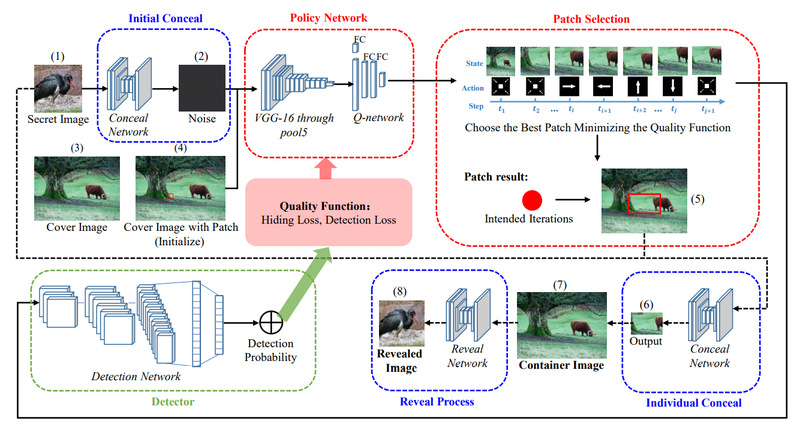Recently, the research group led by Dr. Mingli Song has proposed a method for image steganography that mimics the game of hide-and-seek. The work, Seek-and-Hide: Adversarial Steganography via Deep Reinforcement Learning, was published in IEEE Transactions on Pattern Analysis and Machine Intelligence (DOI 10.1109/TPAMI.2021.3114555).

Image steganography involves hiding information by hiding one image, called the secret image, within other images, called cover images. Analogous to hiding and finding in real-world hiding games, the group asks three main questions: where to hide, to what extent, and how to hide. Using deep neural networks for local image steganography makes information hiding and hiding more secure. Moreover, the group proposes an adaptive local image steganography method based on adversarial examples. This method uses deep reinforcement learning to search for appropriate locations for each input cover image to facilitate hiding, and uses non-robust features of the adversarial examples as hiding information to make hiding more satisfactory. With the proposed bulk feature and policy network, the intelligence can find the safest place for hiding given the initial region of interest of the cover image.
To access the abstract and the article, please visit https://ieeexplore.ieee.org/document/9546656.
About Professor Song
Mingli Song is currently a jointly appointed professor in College of Computer Science and Technology and SIAS, Zhejiang University. He is leading Vision Intelligence and Pattern Analysis (VIPA) Group of ZJU. He received his Ph. D degree in Computer Science and Technology from College of Computer Science, Zhejiang University, and B. Eng. Degree from Northwestern Polytechnical University. He was awarded Microsoft Research Fellowship in 2004.
His research interests mainly include Computational Vision, Pattern Recognition, Machine Learning, Embedded Machine Vision and Visual Interaction. He has authored and co-authored more than 120 scientific articles at top venues including IEEE T-PAMI, IEEE T-IP, T-MM, T-SMCB, Information Sciences, Pattern Recognition, CVPR, ECCV and ACM MM.
He is an associate editor of Information Sciences, Neurocomputing and an editorial advisory board member of Recent Patent on Signal Processing. He has served with more than 10 major international conferences including ICDM, ACM Multimedia, ICIP, ICASSP, ICME, PCM, PSIVT and CAIP, and more than 10 prestigious international journals including T-IP, T-VCG, T-KDE, T-MM, T-CSVT, and TSMCB. He is a Senior Member of IEEE, and Professional Member of ACM.
About SIAS
Shanghai Institute for Advanced Study of Zhejiang University (SIAS) is a jointly launched new institution of research and development by Shanghai Municipal Government and Zhejiang University in June, 2020. The platform represents an intersection of technology and economic development, serving as a market leading trail blazer to cultivate a novel community for innovation amongst enterprises.
SIAS is seeking top talents working on the frontiers of computational sciences who can envision and actualize a research program that will bring out new solutions to areas include, but not limited to, Artificial Intelligence, Computational Biology, Computational Engineering and Fintech.

